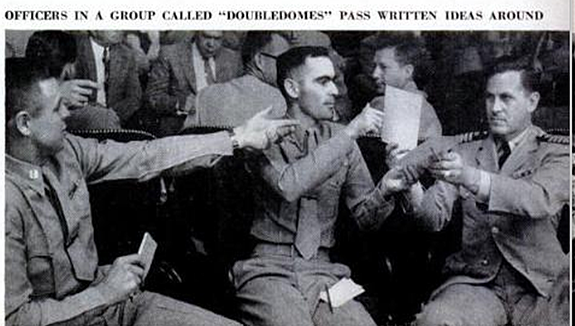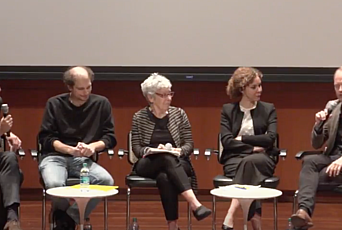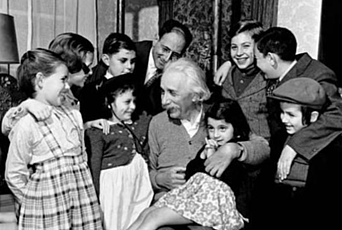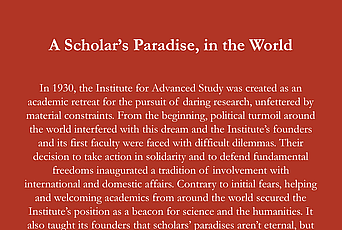Discipline and Creativity

On April 6, 1960, Institute for Advanced Study Director Robert Oppenheimer received a letter from psychologist John E. Drevdahl, requesting his support in setting up a study among IAS Members to assess the factors that made them creative. Thus far, Miami University-based Drevdahl wrote, most studies were “based upon Air Force captains and industrial chemists,” noting understatedly that “I do not feel that [this]… resulted in the identification of those personality factors which are most characteristic of a truly creative and productive researcher.” While it is easy to relate to Drevdahl’s intuition that the military and industry were not the most suitable places to capture creative thinking, it was in those very places that creativity theories and techniques were flourishing in the United States at the time.
My research project on the social history of creativity shows that in the decade preceding the correspondence, processes to garner new ideas and techniques to think “beyond” existing bodies of knowledge became an object of professional interest in a contact zone of industry, the military, and academia. Various elements of the military were early sites for the introduction of creative ideation techniques. Imagine for instance a psychologist (Abraham Maslow no less) imploring military officers in 1957 to get in touch with their unconscious: “out of this unconscious, out of this deeper self, out of this portion of ourselves of which we generally are afraid and therefore try to keep under control, out of this comes the ability to play—to enjoy, to fantasy, to laugh, to loaf, to be spontaneous.” By 1964, at least 50,000 Air Force members had taken creative problem-solving courses. U.S. Steel, Reynolds Metals, Ethyl Corp, GE Motors, New York Telephone Company, and Boeing Airplane were some of the earliest industrial places where free-wheeling buzz sessions, brainstorms, and group thinks emerged.
The scientific study of creativity, as carried out by Drevdahl and numerous others at the time, can be regarded as a legitimating element in this professionalization process. The field of creativity studies drew on a motley set of practitioners from military and industrial settings, engineers, philosophers, anthropologists, and psychologists. Many of their research endeavors were generously supported by military funding. The Cold War provided a generative backdrop for much of the interest in creative ideation, as it highlighted numerous pressing situations that necessitated a move beyond existing knowledge. In military survival training, for instance, recruits were exposed to creative thinking techniques in an effort to retrain them to “think” for themselves in unforeseen situations. Atomic future studies required participants to think the unthinkable and thus to let go of “fixed thinking.” As befitted the Cold War atmosphere, Drevdahl’s creativity study was also framed as a matter of national security. “[T]he survival of this nation, and perhaps, even of Western civilization,” he argued, depended on future creators. His thesis was that the most creative people were “of only moderately superior intelligence” (which does beg the question why he was keen to study IAS Members). Rather than intelligence, he hypothesized, “personality” might be the deciding factor in creativity, and personality was amenable to change, in that it was “produced by a person’s environment.” If his hypothesis that creativity was a matter of nurture rather than nature was correct, the United States government could step in by fostering an educational and institutional ecosystem that would “create more creative people.”
Drevdahl’s study can be regarded as a piece of what came to be called the “Sputnik-inspired era of creativity.” It was supported by United States funding from the National Defense Education Act (NDEA), which had been initiated following the shock of Sputnik. With the model of a plastic population whose creative abilities could be cultivated, one of the NDEA-sponsored challenges was to detect creative citizens. And indeed, the field of creativity studies participated in the widespread testing of the U.S. population. Besides Air Force captains and industrial chemists––and often in addition to both–– children were subjected to a variety of tests meant to capture their creative ability. In addition to standard intelligence tests, soldiers and children were subjected to Rorschach tests, symbol-equivalence tests, Thematic Apperception Tests, drawing completion tests, figure preference tests, anagram tests, and mosaic construction tests. These tests were meant to detect those creative individuals whose future knowledge might contribute to national security. The Torrance Test for Creative Thinking was perhaps most successful in making creativity a measurable attribute, even as creativity’s operationalization–– almost by definition––remained elusive.
While creativity was an object of scientific inquiry and a generative practice in military and industrial settings, it was at the same time pitted against predominant utilitarian rationalities. Creativity emerged precisely in those highly regimented settings in which thinking inside the box was institutionalized through military protocols or managerial rationalities. In these settings where knowledge-formation was under pressure, calls for anti-conformity, for the bracketing of the question of usefulness, and for non-hierarchical free thinking were made in an organized quest to overcome the limits of boxed-in thought. At its best, these calls for what I call “counter-knowledge”––knowledge that comes about by not following the existing rules of thought––were self-reflexive responses of managers and supervisors of highly rationalized workplaces who were concerned about the limiting effects of their own organization on knowledge production.
The early handbooks that were adopted in these settings are remarkable for a number of reasons. In their calls for thinking beyond existing knowledge, handbooks drew on (and fostered) a language of anti-conformity, free association, and the bracketing of usefulness. Many techniques were geared at collective creativity, although later manuals were adapted to include techniques for individuals to hone their creative self (and either way, it was cast as self-satisfying for the newly emerging “creative man”). They index a shift away from experience, which is deemed inadequate to think through the challenges of the present, let alone of the future. In creative thinking techniques, one should, instead, train oneself to be unencumbered by any past insights. This also explains the egalitarian principle that “everybody has ideas,” widely promoted in many of the manuals. A Time report from 1957 gave a description of a brainstorm session:
They sit around in a comfortable, yellow-painted (yellow is considered conducive to thought) brainstorm room furnished in homey knotty pine, have plenty of pads, pencils and cigarettes. Lunch is served, then the session begins. A central problem . . . is presented, and everyone storms ahead. No idea is too fantastic; a cardinal rule is that no one laughs at an idea. If anyone is thoughtless enough to say, “It won’t work,” he is sternly reminded that such remarks are taboo by the chief brainstormer, who clangs a schoolmarm’s bell at him.
As can be gleaned from the “stern reminder,” to get at new ideas, early creative thinking techniques were very disciplined undertakings. Brainstorming was originally defined, for instance, in military idiom. One was “using the brain to storm a problem,” and freely associated “in commando fashion.” Creativity was cast as embodied practice, in which one had to train one’s mental muscle to “think freely” (rather than judiciously). Creative thinking techniques thus alluded to a managed form of freedom. Scientists, workers, engineers, military officers, and housewives had to manage their own minds so as to think more and differently––to overcome inhibitions, to learn to freely associate, to mine their unconsciousness.
Despite its semantics of pushing thought beyond the boundaries of existing knowledge, creative thinking was usually undertaken with a fairly limiting goal in mind. It was geared at problem solving––in government, in corporations, in engineering, in warfare. Hence, just as “thinking outside the box” refers to the solution to a problem by thinking creatively about the quandary of a nine-dot square puzzle, creativity itself, despite its connotations of operating in a space “beyond” existing knowledge, was very much related to––but not questioning––the territory of the problems that call for its employment.1 Moreover, even if the hierarchical organization was criticized in the creative practices, and even as participants were encouraged to think for themselves, the ideation was organized specifically to serve institutions, to increase the knowledge base of organizations like the military or manufacturing corporations. Hence, while setting up a dichotomy in which time is being sequestered from all too practical matters (semantically not unlike the IAS founding principles), creative thinking techniques were in the end geared at useful knowledge. Free association, creative ideation, and free-wheeling brainstorm sessions were used to engage unknowns (how to survive behind enemy lines, how to rebuild infrastructures after an atomic attack). These unknowns were not an occasion to facilitate the pursuit of curiosity, let alone to rethink the framing of the problem, but to enable concrete knowledge production within the parameters of the problem. The survival of the U.S. population, it was said, and at least of soldiers, depended on it. Creative thinking techniques were developed and disseminated in military survival courses, not to ignite blue-sky research, nor to raise questions about the (f)utility of war, but to facilitate very concrete survival in unforeseen situations. Even the U.S. response to the Sputnik shock–– which instigated a serious self-examination regarding knowledge production and a renewed commitment towards science and education––was very much focused on training citizens to solve particular challenges in the near future (moonshots were in those days really that, efforts to reach the moon).
While IAS founding Director Abraham Flexner boldly stated that practical use was not the justification for scientific pursuits, the practical use was thus the justification for the introduction of creative thinking techniques in military and industrial settings. To be sure, the language of uselessness was espoused in creative thinking techniques, but its incorporation indexed that uselessness was, ironically, made applicable, and thus defanged from the temporal and fundamental conditions that characterize and sustain basic research. Similarly, while Flexner’s call for the cultivation of curiosity was predicated on protection from being “deflected by considerations of immediacy of application,” in creative thinking techniques, the immediacy of application was also bracketed… but only briefly. The timescales of knowledge-production in creative thinking techniques and in fundamental science are in a sense incommensurable. While by its very nature, in fundamental science, you don’t know what you are going to find, nor when, in the case of brainstorming––which prohibited immediate calls for practicability, think of the schoolmarm’s bell in the quote above which was to induce laughter and a return to a free-wheeling mood––ideas were often sorted out by supervisors within twenty-four hours. Creative thinking techniques were thus geared at thinking something now.
In sum, the processes of problem solving and the pursuit of fundamental science are often defined as contradistinctive. At the very least, their temporalities of inquiry are incommensurable (compare one day to thirty years). Moreover, whereas in creative thinking exercises, the problem is not itself up for reconsideration, examining the very formulation of the problem is at the heart of basic science. Thus, while some of the language is similar––the objective of a move beyond existing knowledge through freedom of thought, the unlocking of creative thoughts through a deferral of questions of utility, and a seclusion from practical matters––the institutional conditions of both pursuits of knowledge are wildly dissimilar. Creative thinking techniques were primarily peddled in settings where thinking was boxed in. At the IAS, by design, there are no institutionally enforced limits to knowledge production that would propel one to “look beyond” those strictures. On the contrary, its very institutionalization of freedom (including the freedom from practical obligations) make more self-disciplining or managerial creative thinking practices unnecessary. Which is not, by any means, to say that the IAS doesn’t foster creativity, but given the conditions under which IAS Members are laboring, they hardly required disciplinary actions. The IAS is of course a curious place to extricate creativity from intelligence to begin with (as Drevdahl proposed). And as a place for an academic elite, it is probably not the best representative of the principle that “everybody has ideas.” What is more, this elite is not a population that is particularly amenable to measurement (as soldiers and children may be). Oppenheimer stated as much, by explaining that it was not proper for him to encourage Drevdahl to contact the IAS Members, “nor is it consistent with the conditions of membership that our members, as members, be encumbered with any such operations.” A creativity researcher descending on IAS’s grounds might just be the thing that would get in the way of Members’ emerging thoughts.
1 In these puzzles, all nine dots should be passed by drawing four continuous straight lines without lifting the pencil – this puzzle can only be solved by drawing outside the nine dots.
References
Flexner, Abraham 1939. “The Usefulness of Useless Knowledge,” Harper’s.
March 6, 1960, letter from Drevdahl, John E. to Oppenheimer, J. Robert, Director's Office: General files, Box 16, folder Di-Dz (2) [pp. 42–73], From the Shelby White and Leon Levy Archives Center, Institute for Advanced Study, Princeton, NJ, USA.
March 8, 1960, letter from Oppenheimer, J. Robert to Drevdahl, John E., Director's Office: General files, Box 16, folder Di-Dz (2) [pp. 41], From the Shelby White and Leon Levy Archives Center, Institute for Advanced Study, Princeton, NJ, USA.
Maslow, Abraham H. 1962 [1957]. “Emotional Blocks to Creativity,” In A Source Book for Creative Thinking, ed. Sidney J. Parnes, Harold F. Harding, 93-104. New York, NY: Scribner, pp. 96.
Wessinger, William D. 1964. A study of Creative Thinking as it Relates to Military Problem-Solving and Decision Making in the Navy. U.S. Naval Postgraduate School, Monterey, California, pp. 144.


